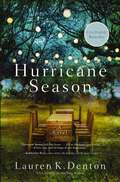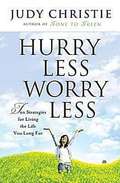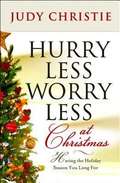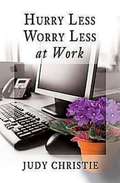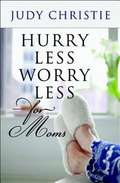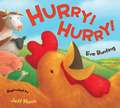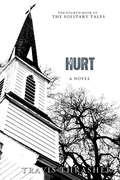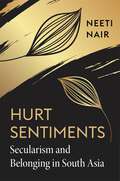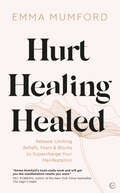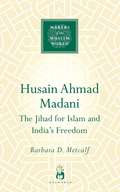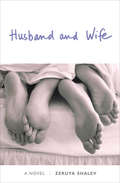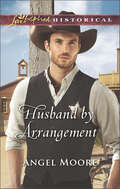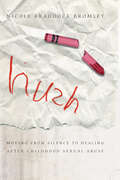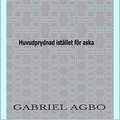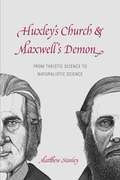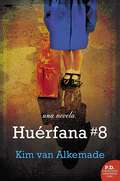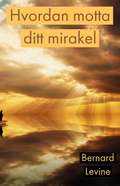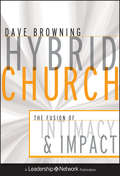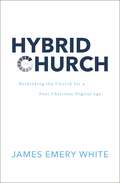- Table View
- List View
Hurricane Season: A Southern Novel of Two Sisters and the Storms They Must Weather
by Lauren K. DentonFrom the author of the USA TODAY bestseller The Hideaway comes a new story about families and mending the past.Betsy and Ty Franklin, owners of Franklin Dairy Farm in southern Alabama, have long since buried their desire for children of their own. While Ty manages their herd of dairy cows, Betsy busies herself with the farm’s day-to-day operations and tries to forget her dream of motherhood. But when her free-spirited sister, Jenna, drops off her two young daughters for “just two weeks,” Betsy’s carefully constructed wall of self-protection begins to crumble.As the two weeks stretch deeper into the Alabama summer, Betsy and Ty learn to navigate the new additions in their world—and revel in the laughter that now fills their home. Meanwhile, record temperatures promise to usher in the most active hurricane season in decades.Attending an art retreat four hundred miles away, Jenna is fighting her own battles. She finally has time and energy to focus on her photography, a lifelong ambition. But she wonders how her rediscovered passion can fit in with the life she’s made back home as a single mom.When Hurricane Ingrid aims a steady eye at the Alabama coast, Jenna must make a decision that will change her family’s future, even as Betsy and Ty try to protect their beloved farm and their hearts. Hurricane Season is the story of one family’s unconventional journey to healing—and the relationships that must be mended along the way.
Hurry Less, Worry Less
by Judy ChristieHurry Less, Worry Less is intended for all those busy women and men who want to slow their lives down but don't quite know where to start. It offers strategies for change, and an invitation to a Christian life. The author writes: "This book shares the path that I took and is written with the certainty that there is a better way to live, even in these hectic times...especially in these hectic times. An unexpected part of the journey was how God began to speak to me and help me grow. I discovered that part of the yearning inside me was for this underdeveloped part of my life." Chapters include: 1. What do you long for?2. Create a new roadmap for your life3. Begin to believe that you have enough time4. Learn to make this work at work5. Lighten the load on your mind6. Listen for guidance in a noisy world7. Fight fear8. Enjoy the journey9. Seek God's will10. Keep at it Includes Resources for the Road (recommended reading and reflection questions).
Hurry Less, Worry Less at Christmas
by Judy ChristieJudy Christie meets us where we are, in a frenzied, out-of-control frame of mind, and helps us begin to have a deeper understanding of the joy of the Christmas season and its deep meaning for our lives overall--and how that can be a starting point for a more abundant life in the new year. In Hurry Less, Worry Less at Christmas, Christie guides us to a more helpful, Christian understanding of this time of year. Aspects of the liturgical calendar are introduced as part of this process, including the Christian understandings of Advent, Christmas, and Epiphany. She gives us practical tools for coping with holiday pressures but above all stresses the need for transformation from a secular perspective to a Christian one. Hurry Less Worry Less at Christmas will assist in identifying what people love about the holiday season and what they want to change. The book can also be used as a study book for church small groups or Sunday school classes, leading up to the holidays. This updated edition contains new content to help make the Christmas season even more joyful, peaceful, and meaningful. "In her delightful, contemporary, and practical book, Judy Christie takes the 'Grinch' out of holiday preparations. She enabled me to see Christmas as a sacred, joyful journey rather than a difficult, demanding marathon." --Nell W. Mohney, Author of Slay Your Giants "Judy Christie must have been reading my mind! I've already started planning a simpler, calmer holiday season this year." --Cynthia Bond Hopson, Author of Bad Hair Days, Rainy Days, and Mondays "Judy Christie provides a welcome reminder to wait upon the Lord, and some practical, real-life steps toward comfort, joy, and simplicity." --Rob Weber, Co-author of Beginnings: The Spiritual Life
Hurry Less, Worry Less at Work
by Judy Christie Books Such Literary AgencyBalance your life at work with your life outside of work. This book offers practical ideas and strategies to help you being your own path toward change and greater balance. Each chapter includes questions and simple steps to consider, tips from real people, helpful scripture verses for guidance, and prayers for your journey. It also includes a chapter-by-chapter study guide, which can be used individually or with a group.
Hurry Less, Worry Less for Families
by Judy ChristieThis book offers useful tips and tools for shaping the kind of family life you want, whatever stage of life you are in, and for exploring answers to questions most families face. In addition to the author's observations, thoughts, and experiences about family life, readers also will find comments from several busy, hardworking mothers and fathers who know how tough and wonderful family life is, along with insights into family life from everyone from young children to retired adults. As the author says, there are no "perfect" families, but there are successes in the lives of many who have learned to rely upon God and to get back up when they stumble. The hope is that within this book you will recognize many of those kinds of achievements within your own family and find new inspiration and encouragement for moving forward with greater faith, joy, and love.
Hurry Less, Worry Less for Moms
by Judy ChristiePopular author Judy Christie contends that, while the perfect mom doesn't exist, there are successes in the lives of many mothers who have learned to rely upon God and to get back up when they stumble. Within this book readers will recognize many of those kinds of achievements within their own families and find new inspiration and encouragement for moving forward with greater faith, joy, and love. The Hurry Less, Worry Less series is for all those busy women and men who want to slow their lives down but don't quite know where to start. It offers quick tips, strategies for change, and an invitation to a Christian life.
Hurry! Hurry!
by Eve BuntingRooster is spreading the word: "Hurry! Hurry!" The crowd gets bigger, faster, and noisier as all the animals follow Rooster, arriving at the peaceful barn just in time to greet the tiniest member of the farm family as he pecks his way out of his egg. Now in a board book edition, Eve Bunting's simple, energetic text and Jeff Mack's vibrant illustrations come together in a joyful, welcoming book that's perfect for preschoolers.
Hurry! Hurry!
by Eve Bunting Jeff MackRooster is spreading the word: Hurry! Hurry! All the animals rush to the barn--and arrive just in time to greet the tiniest member of the farm family, hatching out of his egg. Eve Bunting's simple energetic text and Jeff Mack's colorful art come together in a joyful book that's perfect for preschoolers.
Hurt
by Travis ThrasherHis Rebellion Will Soon Turn to Hope When Chris Buckley first encountered the mysteries of creepy Solitary, North Carolina, he had little idea how far he would fall into the town's shadows. After losing the love of his life, Chris tried to do things his way. He hunted answers. Then he gave up trying to find them. But now Chris comes back to Solitary knowing there's a purpose for his being there. As he watches his place in a twisted and evil bloodline become clear, Chris waits for the last battle--and wonders who will be left when he finally makes his stand. The fourth and final book in the Solitary Tales shines light into deep darkness as Chris's journey to Solitary comes to a dramatic close.
Hurt Sentiments: Secularism and Belonging in South Asia
by Neeti NairAn insightful history of censorship, hate speech, and majoritarianism in post-partition South Asia.At the time of the India-Pakistan partition in 1947, it was widely expected that India would be secular, home to members of different religious traditions and communities, whereas Pakistan would be a homeland for Muslims and an Islamic state. Seventy-five years later, India is on the precipice of declaring itself a Hindu state, and Pakistan has drawn ever narrower interpretations of what it means to be an Islamic republic. Bangladesh, the former eastern wing of Pakistan, has swung between professing secularism and Islam.Neeti Nair assesses landmark debates since partition—debates over the constitutional status of religious minorities and the meanings of secularism and Islam that have evolved to meet the demands of populist electoral majorities. She crosses political and territorial boundaries to bring together cases of censorship in India, Pakistan, and Bangladesh, each involving claims of “hurt sentiments” on the part of individuals and religious communities. Such cases, while debated in the subcontinent’s courts and parliaments, are increasingly decided on its streets in acts of vigilantism.Hurt Sentiments offers historical context to illuminate how claims of hurt religious sentiments have been weaponized by majorities. Disputes over hate speech and censorship, Nair argues, have materially influenced questions of minority representation and belonging that partition was supposed to have resolved. Meanwhile, growing legal recognition and political solicitation of religious sentiments have fueled a secular resistance.
Hurt, Healing, Healed: Release Limiting Beliefs, Fears & Blocks to Supercharge Your Manifestation
by Emma MumfordA uniquely powerful take on emotional healing that combines super-charged manifestation skills and the Law of Attraction with deep healing work, by award-winning spiritual coach and mentor Emma Mumford.This is the only book on the Law of Attraction vou need. Take your manifestation powers to the next level and change your life forever.This is Spiritual Queen Emma Mumford's practical guide to identifying and releasing the limiting beliefs, fears and blocks that stop you from manifesting your desires. Using the Law of Attraction and other spiritual methods, Hurt Healing Healed offers a programme of inner healing techniques to help you to find freedom from the past and heal your emotional pain and trauma. Emma's simple and accessible techniques include:Working through sources of pain in your pastExploring and raising your inner vibration and energyReconnecting to your true self with unconditional loveExploring your personal history and rewriting limiting beliefsOvercoming your blockages and resistance to reignite your manifesting powers"Emma Mumford presents an essential guide for those ready to embark upon the path to high vibes and healing." – KYLE GRAY, bestselling author of Raise Your Vibration "Emma Mumford's tools really work and will get you the manifestation results you want." – MEL ROBBINS, author of the New York Times bestseller The High 5 Habit
Hurting Yet Whole: Reconciling Body and Spirit in Chronic Pain and Illness
by Liuan HuskaWhat if the things we most fear about our bodies—our vulnerability to illness and pain—are exactly the places where God meets us most fully? As Liuan Huska went through years of chronic pain, she wondered why God seemed absent and questioned some of the common assumptions about healing. What do we do when our bodies don't work the way they should? What is healing, when one has a chronic illness? Can we still be whole when our bodies suffer? The Christian story speaks to our experiences of pain and illness. In the embodiment of Jesus' life, we see an embrace of the body and all of the discomfort and sufferings of being human. Countering a Gnosticism that pits body against spirit, Huska takes us on a journey of exploring how healing is not an escape from the limits of the body, but becoming whole as souls in bodies and bodies with souls. As chronic pain forces us to pay attention to our bodies' vulnerability, we come to embrace the fullness of our broken yet beautiful bodies. She helps us redefine what it means to find healing and wholeness even in the midst of ongoing pain.
Husain Ahmad Madani: The Jihad for Islam and India's Freedom (Makers of the Muslim World)
by Barbara MetcalfMaulana Husain Ahmad Madani (1879 - 1957) was a political activist, Islamic scholar, and supporter of Gandhi during the struggle for India's independence. Humane and fiercely dedicated whether campaigning against the separation of Pakistan, or in favour of democracy and inter-religious peace, he brooked no nonsense and fought relentlessly for what he believed in. Spanning a lifetime of campaigning and controversy, Barbara Metcalf's compelling biography draws from Madani's letters and autobiographies, as well as detailed knowledge of the prevailing political climate, to create an intimate and revealing account of one of the most important men in the recent history of Islam.
Husband and Wife: A Novel
by Zeruya ShalevFrom the Israeli author of Love Life: “a highly polished and . . . beautifully written story that carries great weights of meaning” (Kirkus Reviews). Zeruya Shalev achieved international literary stardom with her novel Love Life, which The Washington Post Book World called “a brutally honest and often brilliant tour of individual and family psychology.” In Husband and Wife, she takes us into the heartbreak and compromise of a diseased marriage that may or may not be capable of healing. Na’ama and Udi Newman, together with their young daughter Noga, lead a quiet domestic life. But their idyll abruptly ends when Udi—a perfectly healthy man—wakes up one morning unable to move his legs. The doctors can find no physical explanation for his paralysis. It appears to be a symptom, not of illness, but of something far more insidious. This mysterious disruption soon reveals a vicious cycle of jealousy, paranoia, resentment, and accumulated injuries that now threaten to tear their small family apart. In a rush of hallucinogenic imagery, Husband and Wife captures the vulnerability and deceptive comforts of lives intertwined, offering “an acutely intimate portrait of a relationship” (Donna Rifkind, The Baltimore Sun). “Nearly impossible to look away from.” —Elle
Husband by Arrangement: Frontier Matchmaker Bride The Amish Nanny's Sweetheart Accidental Family Husband By Arrangement
by Angel MooreSuddenly a FamilyAfter Rena Livingston’s secret fiancé leaves her pregnant and unwed, her mayor father insists upon a marriage of convenience to Sheriff Scott Braden. Though his motivations are as much about protecting his political career as her reputation, Rena is grateful the standoffish sheriff agrees to the arrangement. At least her child will grow up without the burden of her shame…Scott believed his one chance at love fled with his ex-fiancée, but caring for Rena and her unborn baby exposes a vulnerability he vowed he’d never allow again. When the upcoming election stirs nasty gossip, though, Scott must choose between his commitment to the town and his growing love for Rena and the baby.
Hush: Moving From Silence to Healing After Childhood Sexual Abuse
by Nicole Braddock BromleyChildhood sexual abuse is running rampant, yet it's the best-kept secret in our nation today. Its victims grow into adulthood with their little child's heart trapped in the pain and torment of their past. Nicole Braddock Bromley shares her own story and the steps to moving from silence to healing. Hush exposes the harsh realities of childhood abuse, explains the pain it causes, examines the false beliefs it creates, and empowers survivors to begin a personal journey toward healing by breaking the silence.With words of understanding and comfort, Nicole tells the real-life stories of those whose voices would otherwise never be heard. She is straightforward enough to pierce the hearts of those in a survivor's circle of influence, yet careful to tread lightly on what could be tender words.
Hush: Moving From Silence to Healing After Childhood Sexual Abuse
by Nicole Braddock BromleyChildhood sexual abuse is running rampant, yet it's the best-kept secret in our nation today. Its victims grow into adulthood with their little child's heart trapped in the pain and torment of their past. Nicole Braddock Bromley shares her own story and the steps to moving from silence to healing. Hush exposes the harsh realities of childhood abuse, explains the pain it causes, examines the false beliefs it creates, and empowers survivors to begin a personal journey toward healing by breaking the silence.With words of understanding and comfort, Nicole tells the real-life stories of those whose voices would otherwise never be heard. She is straightforward enough to pierce the hearts of those in a survivor's circle of influence, yet careful to tread lightly on what could be tender words.
Hustling God: Why We Work So Hard for What God Wants to Give
by M. Craig BarnesWe work hard at life. We try to get better jobs, better homes, better relationships, and even a better spirituality. We are like Jacob in the Old Testament. His name means "striver, schemer, supplanter, hustler." He could have been the poster boy for the American Dream. But author Craig Barnes says this is not the way we should be living our lives. We should not try to manipulate and hustle ourselves into a place of advantage with God, a position that has been ours all along. After all, God is the one who climbed down the ladder to be with us. Using true anecdotes from the men, women, and families of the churches he has served, Barnes invites hard-running, stressed-out, burned-out people to stop striving. Life is not something we grasp and clutch to us, but a gift God freely gives. Only when we open our hands can God fill them with the blessings he has been waiting to lavish upon us all along.
Huvudprydnad istället för aska
by Gabriel AgboEn av dygderna som alltid och för evigt uppmuntrar troende att hålla fast vid Gud, även inför en till synes extrem hopplöshet och förtvivlan, är Hans förmåga att ändra de mest obehagliga förhållanden till fördelaktiga vittnesbörd. Du kanske har gjort allt i din mänskliga makt för att komma ur en specifik situation, till ingen nytta. Tyvärr verkar allt dina ansträngningar gav dig vara sorg, smärta, ånger, sorg, skam och tårar. Det är då som att du kan frestas att ifrågasätta Guds kärlek, eller rentav hans existens. Gör inte det, inte än. Läs den här boken först. Gud är fortfarande den som ger oss huvudprydnad istället för aska.
Huxley's Church and Maxwell's Demon: From Theistic Science to Naturalistic Science
by Matthew StanleyDuring the Victorian period, the practice of science shifted from a religious context to a naturalistic one. It is generally assumed that this shift occurred because naturalistic science was distinct from and superior to theistic science. Yet as Huxley’s Church and Maxwell’s Demon reveals, most of the methodological values underlying scientific practice were virtually identical for the theists and the naturalists: each agreed on the importance of the uniformity of natural laws, the use of hypothesis and theory, the moral value of science, and intellectual freedom. But if scientific naturalism did not rise to dominance because of its methodological superiority, then how did it triumph? Matthew Stanley explores the overlap and shift between theistic and naturalistic science through a parallel study of two major scientific figures: James Clerk Maxwell, a devout Christian physicist, and Thomas Henry Huxley, the iconoclast biologist who coined the word agnostic. Both were deeply engaged in the methodological, institutional, and political issues that were crucial to the theistic-naturalistic transformation. What Stanley’s analysis of these figures reveals is that the scientific naturalists executed a number of strategies over a generation to gain control of the institutions of scientific education and to reimagine the history of their discipline. Rather than a sudden revolution, the similarity between theistic and naturalistic science allowed for a relatively smooth transition in practice from the old guard to the new.
Huérfana # 8
by Van Alkemade KimUna fascinante novela debut de ficción histórico del mundo olvidado de los orfanatos judíos de la ciudad de Nueva York.En 1919, Rachel Rabinowitz, de cuatro años de edad, es colocada en el Hogar Infantil Hebreo donde el doctor Mildred Solomon está llevando a cabo una investigación médica en niños. El doctor Solomon somete a Rachel a un proceso experimental con rayos X que establece la reputación del doctor mientras pone en peligro la salud de la niña. Ahora es 1954, y Rachel es enfermera en el hospicio del Hogar Infantil Hebreo para ancianos donde el doctor Solomon se convierte en su paciente. Se da cuenta del poder que tiene sobre el doctor indefenso, Rachel se embarca en un experimento peligroso de su propio diseño. Antes que termine el turno de la noche, Rachel estará obligada a elegir entre el perdón y la venganza.Inspirada en hechos reales, este libro es una poderosa novela sobre la capacidad humana para lastimar y amar.
Hvordan motta ditt mirakel
by Bernard LevineDenne boken er en spennende bok som vil gjøre deg veldig glad når du begynner å oppdage livets hemmeligheter, lykke og suksess. Vær tro mot deg selv og følg ditt hjerte. La miraklene du lengter etter, begynne å komme inn i livet ditt!
Hybrid Church
by Dave BrowningA hands-on resource for both large and small churches It has been predicted that in the twenty-first century extremely large churches would emerge in America that resemble neither an elephant nor a field of mice. Which is better? At one time the answer would have been either/or. Now it's both/and. We want both the intimacy of smallness and the impact of bigness-we want a hybrid of the two. Hybrid Church is a practical guide for clergy and leaders who want to have the best of both church worlds: the intimacy of small "house church" groups and the impact of very large mega-churches. Offers a guide for churches who want to capitalize on their strengths to build intimacy with impact Written by the pastor of one of the "fastest growing" and "most innovative" churches in America with thousands of members organized in small house groups Outlines a vision for how the church of tomorrow could look like the early church. Given that the trend is toward very large and very small, with few churches in the middle, this book will be a welcome resource for both large and small churches.
Hybrid Church: Rethinking the Church for a Post-Christian Digital Age
by James Emery WhiteWe live our lives in both physical and digital community.We need to do ministry the same way.Because of COVID-19, nearly every church in the US was forced to adapt to a quarantine and adopt new ministry strategies, including digital technologies they may have avoided before. When services began to be offered in-person once more, many church leaders said they hoped they'd never have to "live stream" again for the rest of their lives. But then came the shock: people didn't return in droves, and declining attendance steepened. The pandemic had only accelerated the profound cultural changes that were already marginalizing the church and reducing its relevance.In Hybrid Church, James Emery White argues that the post-pandemic church must commit to a hybrid strategy as the only means to reach a post-Christian culture in a digital age.This book will help you rethink the church's approach and stretch you to move beyond the mentality of "that's the way we've always done it." First outlining the dynamics and depths of the new realities we face, White then walks you through major ways of rethinking digital community, strategic thinking, discipleship, and outreach—tackling practical topics like:How to create an online presence that removes unnecessary barriers to engagement and community.How to rethink your church's delivery, both online and in-person.How to meet the spiritual and communal needs of a younger, digitally-native generation.How to shift from a focus on gathering and attendance to a more biblical vision of togetherness and discipleship. Hybrid Church is written to enable pastors and church leaders to see the positive opportunities in the radical changes of the day and to help model a dynamic new approach to ministry.
Hyderabad, British India, and the World
by Eric Lewis BeverleyThis examination of the formally autonomous state of Hyderabad in a global comparative framework challenges the idea of the dominant British Raj as the sole sovereign power in the late colonial period. Beverley argues that Hyderabad's position as a subordinate yet sovereign 'minor state' was not just a legal formality, but that in exercising the right to internal self-government and acting as a conduit for the regeneration of transnational Muslim intellectual and political networks, Hyderabad was indicative of the fragmentation of sovereignty between multiple political entities amidst Empires. By exploring connections with the Muslim world beyond South Asia, law and policy administration along frontiers with the colonial state and urban planning in expanding Hyderabad City, Beverley presents Hyderabad as a locus for experimentation in global and regional forms of political modernity. This book recasts the political geography of late imperialism and historicises Muslim political modernity in South Asia and beyond.
